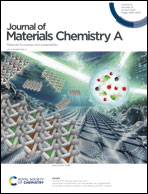Enhanced electrochemical CO2-to-ethylene conversion through second-shell coordination on a Cu single-atom catalyst†
Abstract
Electrocatalytic reduction of carbon dioxide (CO2RR) to C2+ products presents an ideal approach to mitigate the continuous accumulation of CO2 for achieving carbon neutrality. However, the selectivity for C2+ products is constrained by the high energy barrier associated with C–C coupling and the sluggishness of multiple proton-coupled electron transfer (PCET), resulting in reduced efficiency and selectivity. Herein, a single-atom Cu catalyst with second-shell S coordination (Cu–C3N4–S) is prepared, exhibiting higher ethylene (C2H4) faradaic efficiency (60.2% at −0.9 V vs. RHE). The second-shell S doping structure is confirmed using a DFT theoretical model combined with synchrotron X-ray absorption spectroscopy. Simultaneously, the adsorption of *CO2 intermediates is detected by in situ Raman spectroscopy, allowing for the inference of potential reaction pathways. It is confirmed that through the regulation of second-shell S doping, a notable reduction in the energy barrier of C–C coupling ensues, concurrently tackling the electron demand in the PECT reaction via the construction of an electron transfer pathway (S–N–Cu) at a lower overpotential. This study contributes novel insights to the design of atomic-sized copper-based catalysts inspired by the indirect coordination and heteroatom regulation technique.



 Please wait while we load your content...
Please wait while we load your content...